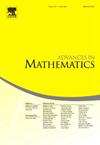Monodromy of generalized Lamé equations with Darboux-Treibich-Verdier potentials: A universal law
IF 1.5
1区 数学
Q1 MATHEMATICS
引用次数: 0
Abstract
The Darboux-Treibich-Verdier (DTV) potential is well-known as a (parametric) doubly-periodic solution of the stationary KdV hierarchy (Treibich and Verdier, 1992) [42]. In this paper, we study the generalized Lamé equation with the DTV potential from the (doubly periodic) monodromy aspect. This equation is the elliptic form of the well-known integral Heun equation. We prove that the map from to the monodromy data satisfies a surprising universal law . Our proof applies the Panlevé VI equation and modular forms. We also give applications to compute the algebraic multiplicity of the (anti)periodic eigenvalues for the associated Hill operator.
求助全文
约1分钟内获得全文
求助全文
来源期刊

Advances in Mathematics
数学-数学
CiteScore
2.80
自引率
5.90%
发文量
497
审稿时长
7.5 months
期刊介绍:
Emphasizing contributions that represent significant advances in all areas of pure mathematics, Advances in Mathematics provides research mathematicians with an effective medium for communicating important recent developments in their areas of specialization to colleagues and to scientists in related disciplines.
 求助内容:
求助内容: 应助结果提醒方式:
应助结果提醒方式:


